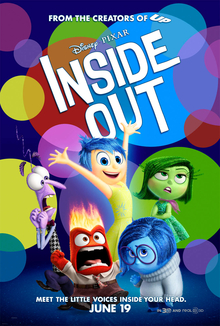
Inside Out is the 15th feature-length computer-animation from Pixar. When 11-year-old Riley (Kaitlyn Dias) and her parents (Kyle MacLachlan and Diane Lane) move from rural Minnesota to San Francisco, the five personified emotions within her head that influence Riley’s actions are unsure of how to navigate this time of change. Having ruled the console throughout Riley’s life, Joy (Amy Poehler) is very optimistic, but when she and Sadness (Phyllis Smith) are forced to embark on an enormous journey through Riley’s mind, Joy starts to realise that happiness is not always the emotion which should be the youngster’s go-to response.
PROS
- Truly exquisite animation that boasts a rich colour palette, crisp visual quality and an abundance of wonderful detail, particularly in the fantastic settings that feature an elaborate amount of background details which really bring the inside of Riley’s mind to vibrant and eye-catching life. Along with the highly expressive character animations and designs, these demonstrate tremendous creativity and imagination on the conceptual artists and animators’ parts.
- Screenwriters Pete Docter, Meg LeFauve and Josh Cooley find an utterly sublime balance between adventure, drama and comedy. The adventure is in the highly creative and imaginative journey which Joy and Sadness undertake through Riley’s mind, whilst the drama is very much character-focused (as will be discussed in subsequent Pros), and the comedy is very sharp and witty, with good moments of comic relief in Anger (Lewis Black) and Disgust (Mindy Kaling), but the most inspired being in the marked contrast between the personified emotions of Riley’s mother and father’s respective minds.
- Joy and Sadness’s journey together is both a wonderfully unique and charming buddy-road-trip narrative and a method of providing them both with rich characterisation as they undergo emotional arcs that make them highly multi-layered characters, regardless of what their names may suggest to the contrary, culminating in a truly emotional and striking climax.
- The most powerful dramatic aspect of the narrative is in the central message that it is okay to be sad at times, it is okay to not be okay. This is an important message for younger viewers who are still trying to comprehend emotions, but also for adults who so often try to bottle up their true feelings about situations, and the true testimony to the screenwriters’ skill is in the fact that they execute this message in a very clever and down-to-Earth manner that is accessible for viewers old and young alike.
- Director Pete Docter takes all three aspects of the narrative (i.e. adventure, comedy and drama), and handles all of them with a very deft hand and a remarkable balance. As for the aforementioned central message, Doctor takes a truly sensitive and compassionate approach. Most of all, no matter how much imagination is on display, he ensures that everything is character-driven.
- A terrific voice cast, with Amy Poehler and Phyllis Smith bringing wonderful emotion and expression to Joy and Sadness, with increasing amounts of emotional range over the runtime; Lewis Black and Mindy Kaling hitting the comedic beats absolutely beautifully as Anger and Disgust. The standout though is Richard Kind’s tremendously expressive and wonderfully energetic turn as Bing Bong, which is truly heartfelt and utterly memorable.
- A beautiful score by Michael Giacchino which is suitably understated, and perfectly compliments the tempo of everything that occurs with wonderful sensitivity, and elevating the emotional weight of the more dramatic scenes and making the rare moments of adrenaline-fuelled adventure more exciting. However, nothing is as a wholesome as Bing Bong’s song.
NITPICKS
- Fear gets less memorable moments than the rest of the emotions, meaning that Bill Hader gets less chance to shine than his co-stars.
- A couple of scenes end slightly abruptly.
VERDICT: 10/10